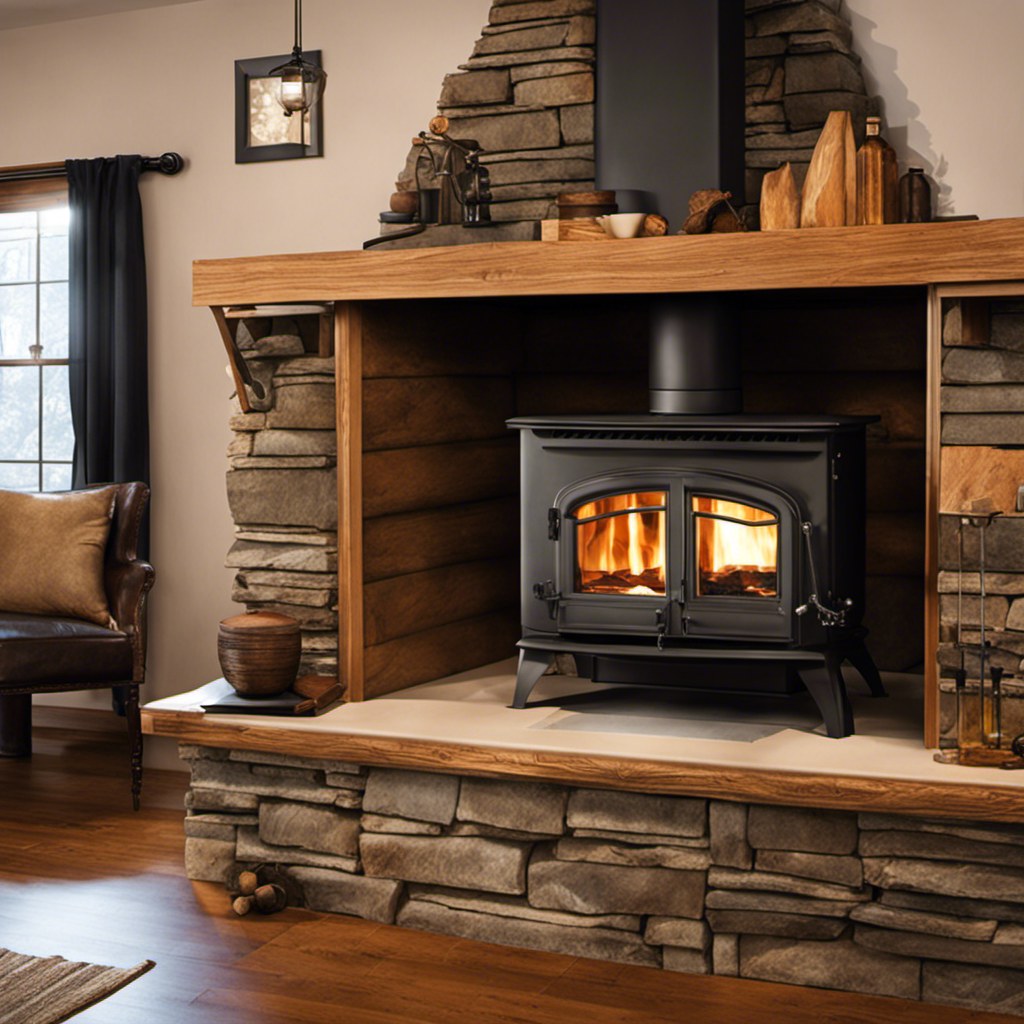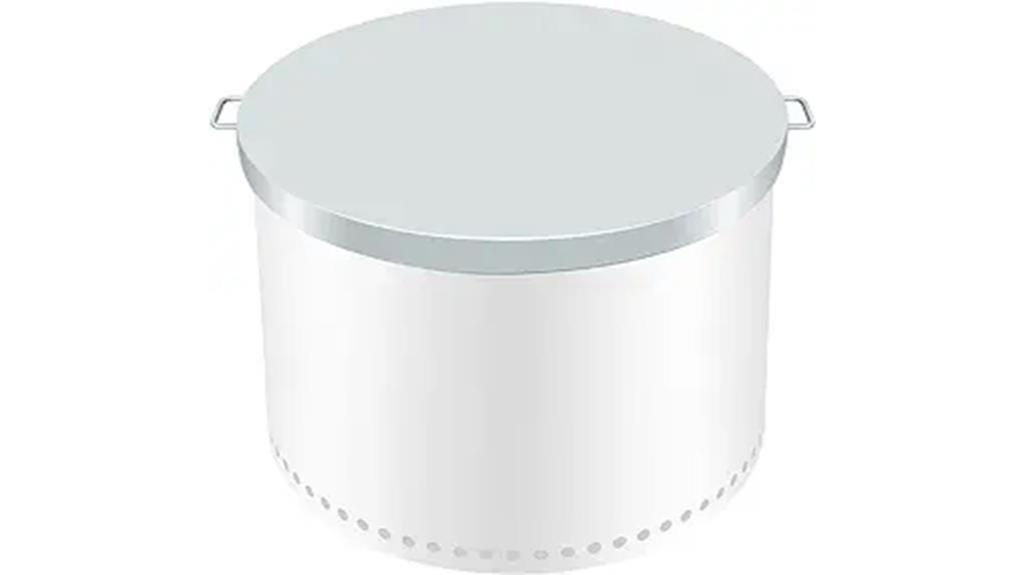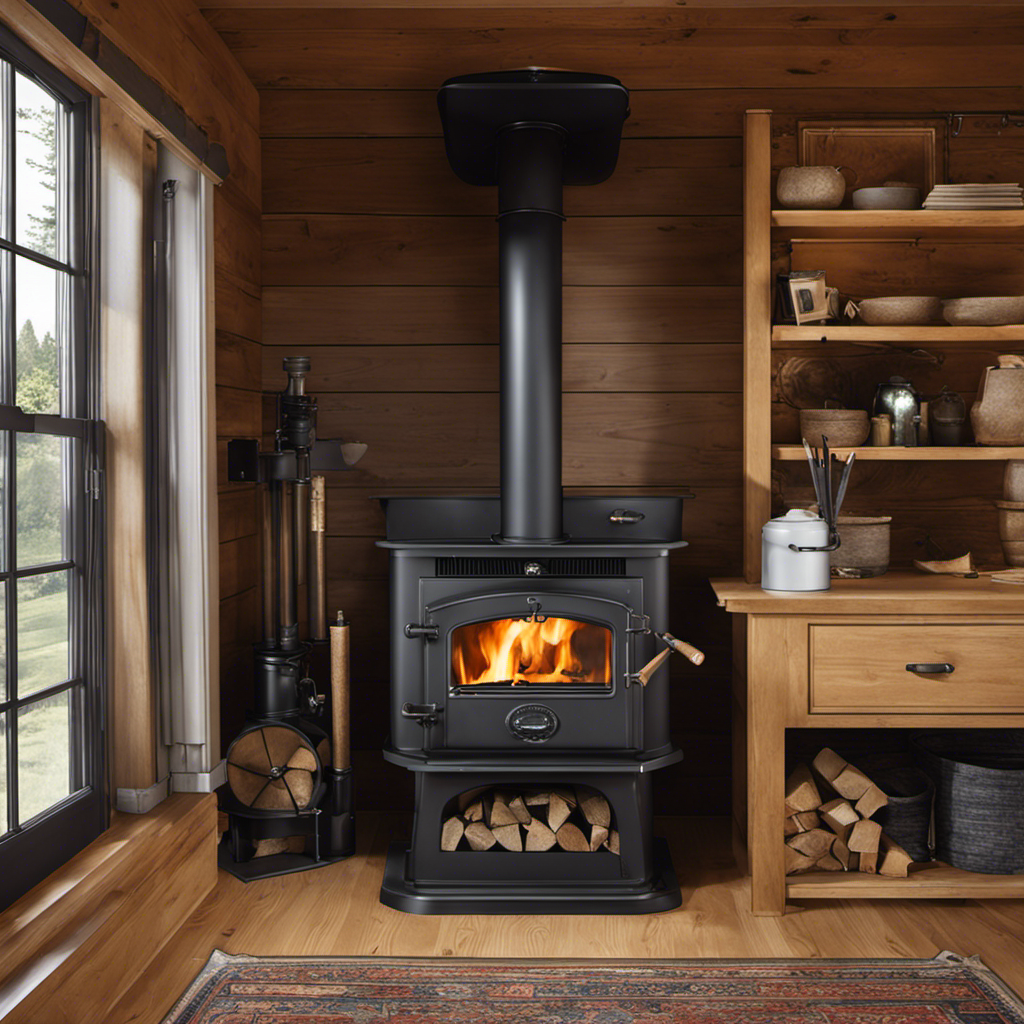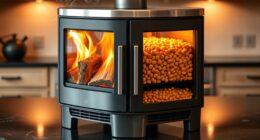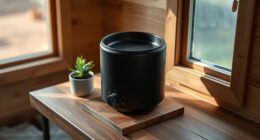I have always enjoyed the comforting warmth that a wood stove adds to the ambiance of my home.
But I’ve also been concerned about the potential fire hazard it can pose.
That’s why I decided to install a heat shield for my wood stove.
In this article, I’ll guide you through the process of choosing the right material, measuring and marking the proper placement, preparing the wall surface, and installing the heat shield panels.
By the end, you’ll have a secure and effective heat shield for your wood stove.
Key Takeaways
- Consider durability and choose the right heat shield material, such as ceramic tiles, sheet metal, mineral wool boards, or gypsum boards.
- Accurately measure and mark the proper placement for the heat shield using a laser level and following manufacturer’s guidelines for required clearance.
- Prepare the wall surface by cleaning, removing loose paint, repairing cracks or holes, and ensuring a clean and smooth surface for heat shield installation.
- Install high-quality heat shield panels, align and secure them carefully, regularly inspect for wear or damage, and clean them periodically with a soft cloth and mild detergent.
Choosing the Right Heat Shield Material
I’m considering the durability of each heat shield material before making a decision. When selecting a heat shield material, there are several factors to consider.
Firstly, let’s discuss the advantages and disadvantages of different options. Ceramic tiles offer excellent heat resistance and are easy to clean, but they can be fragile and prone to cracking. Sheet metal is a cost-effective choice, providing good heat reflection, but it may require regular maintenance to prevent rusting.
Next, there are mineral wool boards, which offer excellent insulation properties and are fire-resistant, but they can be bulky and difficult to install. Lastly, there are gypsum boards, which are lightweight and easy to work with, but they aren’t as heat-resistant as other materials.
Considering these factors, I’ll choose the most suitable heat shield material for my wood stove installation.
Measuring and Marking the Proper Placement for the Heat Shield
Before proceeding with the installation, I’ll carefully measure and mark the proper placement for the heat shield, ensuring optimal safety and efficiency. Determining the necessary clearance is crucial to prevent any potential fire hazards.
To achieve accurate measurements, I’ll utilize a laser level for precise measurements. This tool will allow me to establish a straight and level line, guaranteeing that the heat shield is positioned correctly. By measuring the distance between the heat source and the shield, I can determine the required clearance.
It’s important to follow the manufacturer’s guidelines regarding this clearance to maintain the heat shield’s effectiveness. Once I’ve obtained the necessary measurements, I’ll mark the positions for the brackets or screws that will secure the heat shield in place.
This meticulous process ensures a successful installation and provides peace of mind knowing that I’ve taken all necessary precautions for a safe and efficient heat shield.
Preparing the Wall Surface for Heat Shield Installation
To prepare the wall surface for heat shield installation, there are three important things to consider:
-
Clean the surface: Use a mild detergent and water solution to remove any dirt, grease, or grime from the wall. Scrub gently with a sponge or soft brush and rinse thoroughly.
-
Remove loose paint: Scrape off any loose or peeling paint using a putty knife or scraper. This will create a smooth and even surface for the heat shield installation.
-
Repair any damage: Fill in any cracks or holes in the wall with spackling compound or joint compound. Smooth it out with a putty knife and let it dry completely before proceeding.
Installing the Heat Shield Panels
I’ll carefully align and secure the heat shield panels to ensure maximum protection from heat damage. When installing heat shield panels, it’s crucial to follow proper procedures to guarantee their effectiveness.
Firstly, make sure to choose high-quality heat shield panels that are specifically designed for your wood stove. These panels act as a barrier, reflecting heat away from combustible materials and preventing potential fires.
It’s important to maintain the heat shield regularly to ensure its optimal performance. Regularly inspect the panels for any signs of wear or damage, such as cracks or warping. Clean the heat shield periodically using a soft cloth and mild detergent to remove any dirt or residue.
Securing the Heat Shield and Testing Its Effectiveness
I have securely fastened the heat shield to the wall and will now test its effectiveness against heat damage.
-
The first method of testing the heat shield’s effectiveness is through a heat exposure test. This involves subjecting the shield to high temperatures for a specified period of time and observing any signs of heat damage or degradation.
-
Another testing method is the thermal imaging test. This involves using a thermal camera to measure the temperature distribution on the heat shield’s surface during operation. Any hotspots or areas of excessive heat can indicate potential issues with the shield’s performance.
-
Lastly, regular maintenance is crucial to ensure the heat shield’s effectiveness. This includes inspecting for any signs of wear or damage, cleaning any debris or build-up, and tightening any loose fasteners.
Frequently Asked Questions
How Often Should the Heat Shield Be Cleaned or Maintained?
The heat shield should be cleaned or maintained at least once a year or as needed. It is not recommended to paint the heat shield as it may affect its heat resistance capabilities.
Are There Any Specific Safety Precautions to Consider When Installing a Heat Shield for a Wood Stove?
When installing a heat shield for a wood stove, it’s crucial to prioritize safety precautions. Neglecting them can lead to potential hazards. Avoid common mistakes by following proper installation guidelines and consulting with professionals.
Can a Heat Shield Be Installed on Any Type of Wall Surface?
A heat shield can be installed on various wall surfaces depending on its compatibility. Alternatives include concrete, brick, or metal. It is important to consider the material’s heat resistance and durability to ensure proper installation and safety.
Can a Heat Shield Be Installed on a Ceiling or Floor Surface?
Installing a heat shield on a ceiling or floor surface is possible, but it requires careful consideration. Concrete surfaces can handle the weight, but make sure to follow installation guidelines. Using a heat shield on a wood stove prevents heat damage and increases safety.
Is It Necessary to Hire a Professional to Install a Heat Shield, or Can It Be Done as a DIY Project?
Installing a heat shield for a wood stove can be done as a DIY project, but hiring a professional has its benefits. A DIY heat shield installation allows for cost savings, while professional installation ensures proper placement and compliance with safety regulations.
Conclusion
In conclusion, by choosing the right heat shield material, measuring and marking the proper placement, preparing the wall surface, and installing the heat shield panels, you can effectively protect your home and loved ones from the dangers of a wood stove.
Take the necessary steps to secure the heat shield and test its effectiveness for peace of mind and a safer living environment.
Safeguard your home with a properly installed heat shield today.
Logan’s affair with adventure began in childhood. He hailed from a small town where vast forests bordered one side and endless shores stretched on the other. His days were spent exploring uncharted woods, climbing tall trees, or listening to the tales of old sailors. This early immersion in a world brimming with stories and mysteries became the foundation of his passion for writing.

